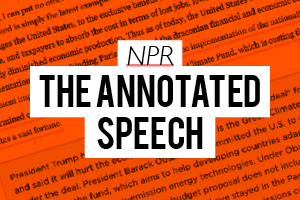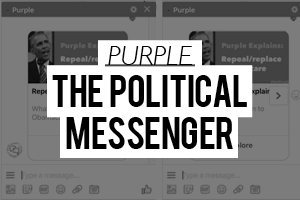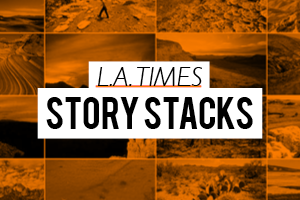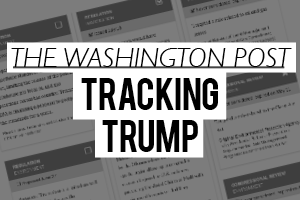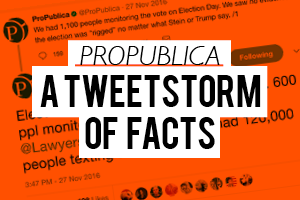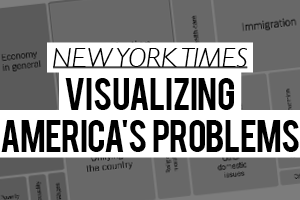The final section of this report examines 11 works of journalism from news organizations around the country that have found effective ways to present facts on complicated issues. First, an introduction to our list.
Any discussion of 21st-century “explainers” must begin with Vox. The online-only news organization is a pioneer in the use of cards or card stacks that function as index cards or “cheat sheets” of background information about complicated, ongoing news stories. Since their development in 2012, the cards have become iconic, copied and iterated by many other news organizations around the world.
While Vox says it’s moving on from its original version of cards, the general idea has proven useful in presenting facts around developing and complex political stories. For instance, NPR used cards to illustrate facts about the reported Russian interference in the 2016 U.S. presidential election.
Instead of assuming that readers come to the latest incremental story with knowledge of the story’s entire history, the cards provide a trove of background facts that goes well beyond the typical one-paragraph summary used in traditional news stories.
“Many readers aren’t well served by an incremental news story about a complicated, ongoing issue,” says Steve Myers, editor of The Lens in New Orleans. “You learn about the latest development, its effects and people’s reactions, but you learn little about what led up to this event and how it fits into the larger picture.”
Typical news stories are “80 to 90 percent news and reaction,” says Myers. The inverse is true for cards and other such projects: They’re 80 to 90 percent context.
In that respect, the cards become an expandable resource for both readers and journalists.
“This makes it easier to collaborate and collect the knowledge of the newsroom, as well as keep the reader up to date no matter their base level of knowledge on the story,” former NPR developer Tyler Fisher says.
While video was an essential element in Jay Rosen’s 2010 “Building a Better Explainer Project” — see this music video on fracking, for example — monetization opportunities and better technology like captioning have made video even more essential. And recent research indicates that short videos “are an effective way of correcting misperceptions” and reducing audience confusion. Video is central to Milwaukee’s Journal-Sentinel project, “Just the FAQs.” The Associated Press also is incorporating video into its longtime “AP Explains” feature.
Well-integrated photography can be more impactful and memorable when used to present facts. This New York Times analysis of protests in Turkey uses photos shot from several angles to investigate the controversy.
A few years ago, quizzes and games exploded as a way to entertain, thanks to BuzzFeed. Other news organizations have repurposed those quizzes as a way to inform readers. This Christian Science Monitor quiz presents correct answers along with context and makes the interactive easy to share. Politico’s Diana D’Abruzzo creates quizzes that offer context, links, and promotion to other Politico content.
Other accountability reporting projects have been developed for specific platforms, like Purple, which uses SMS and Facebook Messenger to deliver facts and context. Still others use story stacks that combine several types of interactives into one presentation, offering readers their choice of entry points into the story. This project from La Nación uses cards, charts, video, annotation and filters to fact-check a presidential speech.
In this report, we’ve selected some top-quality projects from a variety of newsrooms to illustrate the spirit of “recoded” journalism and the range of possibilities when it comes to tackling tough, fact-filled issues.
We hope you will review these projects and ideas and send us your comments, as well as other examples of journalism that use non-traditional formats to check facts and to hold government and political leaders and institutions accountable. We’re interested in making this a conversation that will grow and improve.
The creators of these projects — reporters, designers, photographers, videographers — have generously given us an inside look at the process and results of their work.
We’ll offer modifications for media organizations with various levels of resources, along with a list of easy tools to create factual presentations. But, says Crotts, your staff size or skill level “should not factor into the ability to create” these projects. As an editor, Crotts has experienced pushback from staffers who say, “We don’t have designers or artists, so we can’t do this.”
“That simply is not true. Breaking a story into small chunks of information and not the inverted pyramid is easy for any editor or reporter,” Crotts says. “Anybody with basic print or online design skills should be able to present that information” in an alternative form.
Here are our 11 examples
A Facebook video project sheds light on how redistricting affects North Carolina politics and residents.
A series of first-person interviews, overlaid with graphics and text, succinctly explain top issues.
Share with your network
Improving accountability reporting
You also might be interested in:
As research continues to inform this slice of the news industry, we’ll continue learning, too. Who gets to be called a journalist in 2025 and beyond? What is the future of trustworthy information, especially considering the access to and trust for online content creators? How might journalism adapt to the rise, or co-opt the styles, of news influencers?
What if we started looking at our output as a product, not a service? Too often, we think "product" means a fancy app or a new website. But product isn’t about tech. It’s about intention.
When we began asking what kind of stories still mattered to Baca County, we realized many of them weren’t “breaking news” but generational memory. And the paper was the last remaining platform that treated those memories with care and context.


